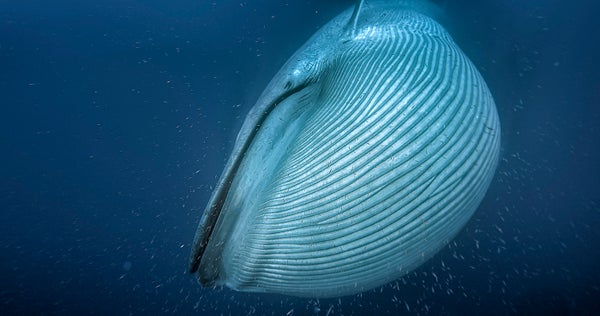The world's most massive animal, the blue whale, is like a 100-passenger jet gliding below the ocean's surface. Whales are among the largest organisms ever to exist, and now scientists say they may know when and why they evolved to be so enormous. In a study published recently in the Proceedings of the Royal Society B, researchers modeled the sizes of baleen whales that lived between roughly 35 million years ago and the present. The team measured the skulls (a known indicator of body size) of 63 extinct whale species from the fossil collection at the Smithsonian Institution's National Museum of Natural History. The scientists then compared these measurements against the sizes of living whales. Their analysis concluded that whale body length had varied randomly for about 30 million years before making a leap to more than 10 meters between 4.5 million and hundreds of thousands of years ago—a stretch of time that straddles the Pliocene and Pleistocene epochs, commonly referred to as the Plio-Pleistocene—which was more recent than previous research suggested. Co-author Graham Slater of the University of Chicago notes that even studies that yielded similar time estimates were based on observation and guesswork and lacked measurements to back them up. He and his colleagues claim to be the first to use a series of statistical models to identify the timing of the change.
Pegging the trend toward giant sizes to the Plio-Pleistocene ruled out other hypotheses such as the threat of predation by the huge shark megalodon—which had already been around for millions of years before the whales' growth spurt—or the advent of filter feeding, which had been around for more than 15 million years at that point.
The new work traces whales' increasing size to changes in food availability resulting from ice ages. As an ice cap formed at the North Pole, freshly cooled water would sink to the bottom of the ocean and then rise again where winds pushed warm surface waters away from the coasts in a seasonal phenomenon known as upwelling. This upward rush of cold water would have brought nutrients to the surface, allowing phytoplankton to bloom and whale prey such as krill to flourish in dense patches at certain times of the year.
On supporting science journalism
If you're enjoying this article, consider supporting our award-winning journalism by subscribing. By purchasing a subscription you are helping to ensure the future of impactful stories about the discoveries and ideas shaping our world today.
Such conditions would have offered an evolutionary boon to a bigger baleen whale, Slater explains. A larger mouth would mean taking in more water and filtering out more prey per gulp, and a larger body could more efficiently travel long distances between feedings. A slow metabolism would help conserve energy, too.
R. Ewan Fordyce, a geologist at the University of Otago in New Zealand, who has studied baleen whale fossils but was not involved in the research, agrees with the findings. But he thinks that other factors may be involved. For example, windblown, iron-rich dust may have fertilized oceanic phytoplankton and could be worth investigating further, Fordyce says.
In future studies, Slater hopes to tighten the time frame for the whales' jump in size. The literature on the Plio-Pleistocene fossil record is disappointingly sparse. “There's less incentive to work on more recent fossil records. But those are really important fossils,” he notes.
